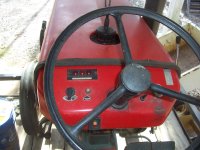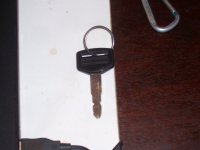old grayfellow
Member
My 186D has for some years had this thing where when I turn the key sometimes I'll just hear the solenoid click but the starter doesn't engage, but if I try the key again 1-3 times it would always eventually engage the starter and the engine would start. Kind of an annoyance but it would always start after a few tries so I didn't track down the problem. A couple years ago I had the feeling it might've been dirty contacts or something in the ignition switch so I took that off and cleaned it all up, no change.
But since yesterday, it has gone to a new level of problem; basically the solenoid doesn't even click, just nothing. I cleaned the battery terminals thoroughly and greased them, and tightened well, but no improvement. Battery voltage is 12.7.
So first I tested voltage at the "trigger wire" on the solenoid. I expected ~12V when key is turned to "start", but it only showed around 3.6V. If I held the key in the start position, voltage would climb gradually over 10 seconds or so, but would only reach about 5.1 volts. So if i'm assuming correctly that the solenoid wire should be supplying 12V looks like this might be the issue (insufficient voltage to trigger the solenoid).
But from this point I'm not clear on why there would be this low voltage. I have some info from a service manual on testing the solenoid, but looks to me like the problem might be upstream of the solenoid.
Found an electrical diagram here: yanmar ym186D \\ circuit diagram
and from what I can see it looks like there should be nothing between (12V) power from the ignition switch and the solenoid except the "safety switch" (which has long been defeated/bridged on my tractor).
So I'm left thinking that it must be a dirty connection somewhere between the ignition switch and the solenoid, though it seems odd that there would be a much reduced voltage (3.6-5V) but consistent.
Am I missing something? Any suggestions?
But since yesterday, it has gone to a new level of problem; basically the solenoid doesn't even click, just nothing. I cleaned the battery terminals thoroughly and greased them, and tightened well, but no improvement. Battery voltage is 12.7.
So first I tested voltage at the "trigger wire" on the solenoid. I expected ~12V when key is turned to "start", but it only showed around 3.6V. If I held the key in the start position, voltage would climb gradually over 10 seconds or so, but would only reach about 5.1 volts. So if i'm assuming correctly that the solenoid wire should be supplying 12V looks like this might be the issue (insufficient voltage to trigger the solenoid).
But from this point I'm not clear on why there would be this low voltage. I have some info from a service manual on testing the solenoid, but looks to me like the problem might be upstream of the solenoid.
Found an electrical diagram here: yanmar ym186D \\ circuit diagram
and from what I can see it looks like there should be nothing between (12V) power from the ignition switch and the solenoid except the "safety switch" (which has long been defeated/bridged on my tractor).
So I'm left thinking that it must be a dirty connection somewhere between the ignition switch and the solenoid, though it seems odd that there would be a much reduced voltage (3.6-5V) but consistent.
Am I missing something? Any suggestions?

